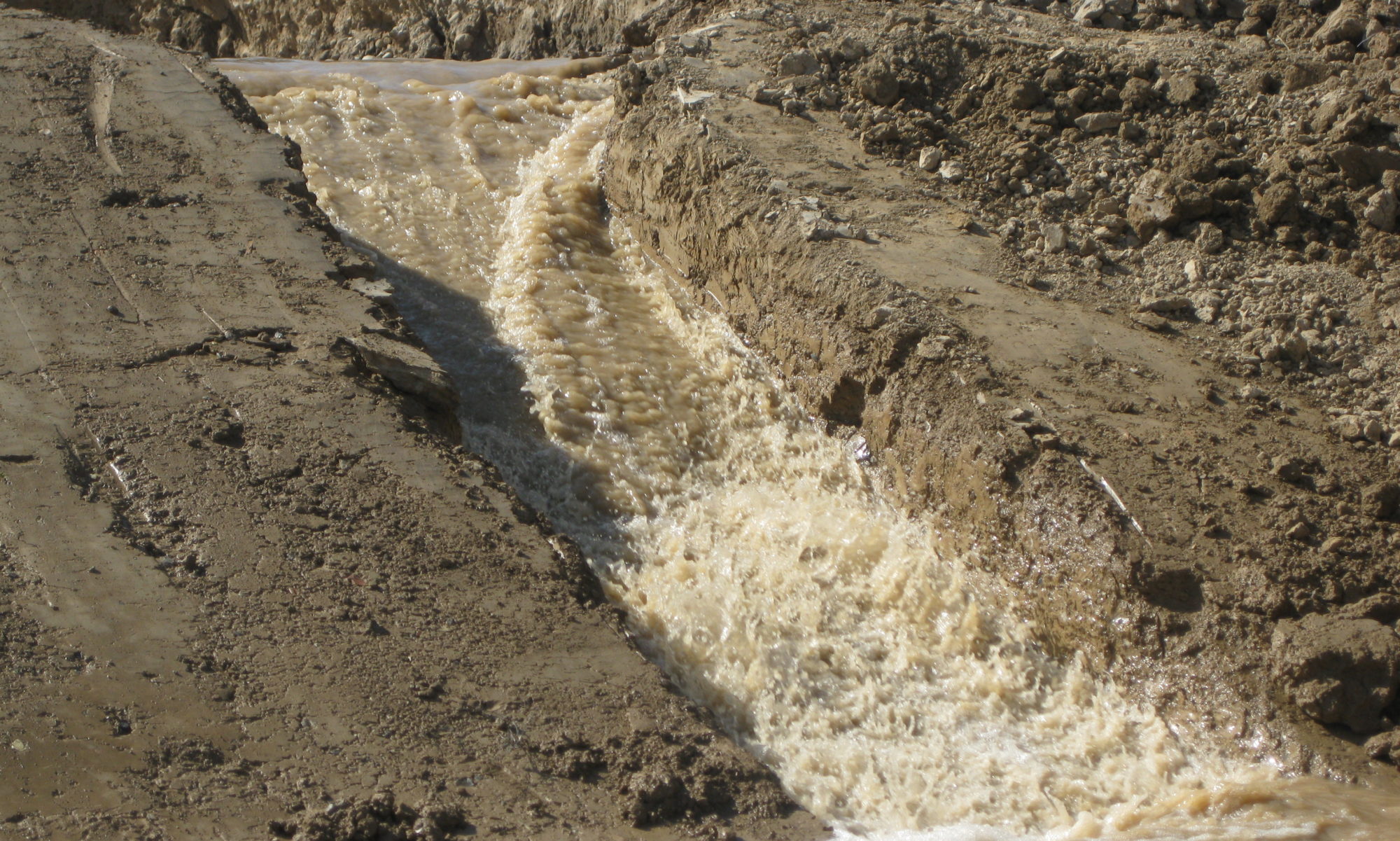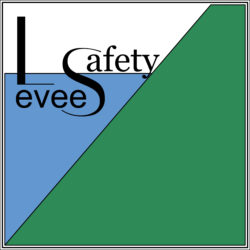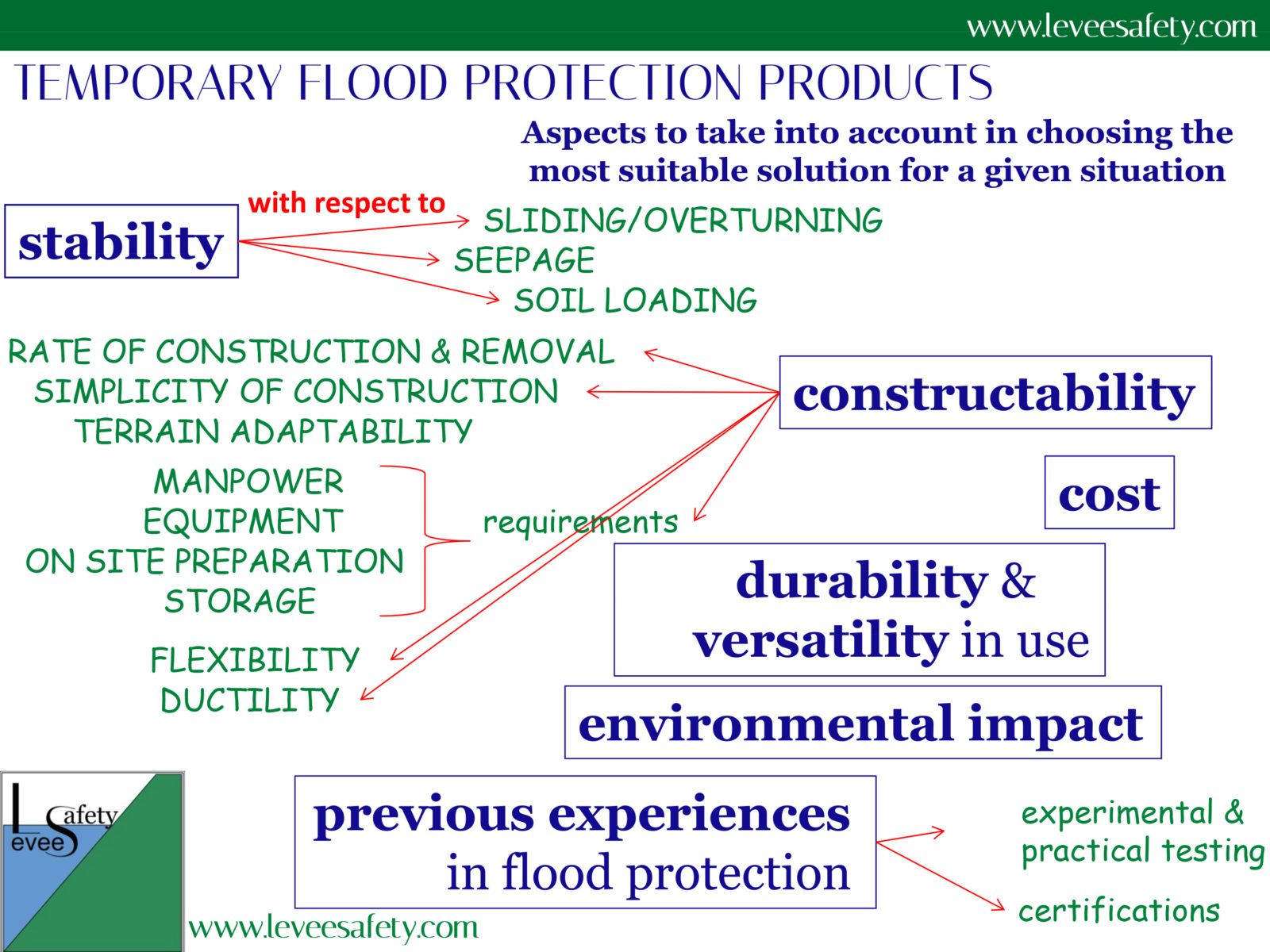Systems for temporary protection are necessary tools in fighting against flooding.
They are removable flood protection systems that are installed during a flood event and removed completely when levels have receded.
Temporary system performance depends on its barrier, its interaction with the subsoil and its end joints and details.
While the foundations for permanent systems are designed as part of the installation of the permanent parts, by their nature, temporary systems are placed on whatever surface or existing foundation is available. Suitability to actual soil conditions is critical to the ability of temporary barriers to provide flood protection.
1. EARTH-FILLED LEVEE BARRIERS
In standard levee design, the configuration of the levee is generally dictated by the foundation soils and the materials available for construction. Even under emergency conditions, an attempt should be made to make the embankment compatible with the foundation.
BARRIER ALIGNMENT
It should:
- be the shortest practical route
- take advantage of any high ground
- avoid potentially unstable river banks
- be kept as far landward of the river as possible to provide maximum foreshore.
BORROW AREA
Borrow sites which will provide suitable materials for emergency levee repairs or construction should be identified in advance of a flood event.
Prerequisites for a borrow area are:
- material adequacy (sand or clay are preferred, silt as a last option)
- accessibility (to the borrow site and from the borrow site to the levees).
FOUNDATION PREPARATION
Prior to embankment or levee construction, the foundation area along the levee alignment should be prepared. This is particularly important if the levee is to be left in place.
MATERIALS
Earth fill materials for emergency levees will usually come from local borrow areas. Compatibly with time limitations, an attempt should be made to utilize materials which are compatible with the foundation materials.
CLAY. It is the preferred soil for levees.
Advantages:
- impervious material
- relatively high resistance to erosion when in a compacted state
- the section can be made smaller (steeper side slopes).
Disadvantage:
adequate compaction is difficult to obtain without proper equipment and when the material is wet.
SAND. The use of sand in flood fight efforts has proved valuable.
Advantages:
- can be placed in inclement weather
- often available from local sources (such as dredged material disposal sites)
Disadvantages:
- it requires more material than clay
- the section should comply specific recommendations
- when overtopped it breaches rapidly
- it allows floodwaters to seep through the barrier.
SILT. Silt should be avoided because upon wetting, tends to collapse under its own weight and is very susceptible to erosion.
LEVEE BARRIER SECTION
Actual levee construction depends on time and available materials. In determining the top width of the section, it should be considered the potential necessity to place additional fill. A top width with adequate room for construction equipment access will facilitate raising the emergency levee.
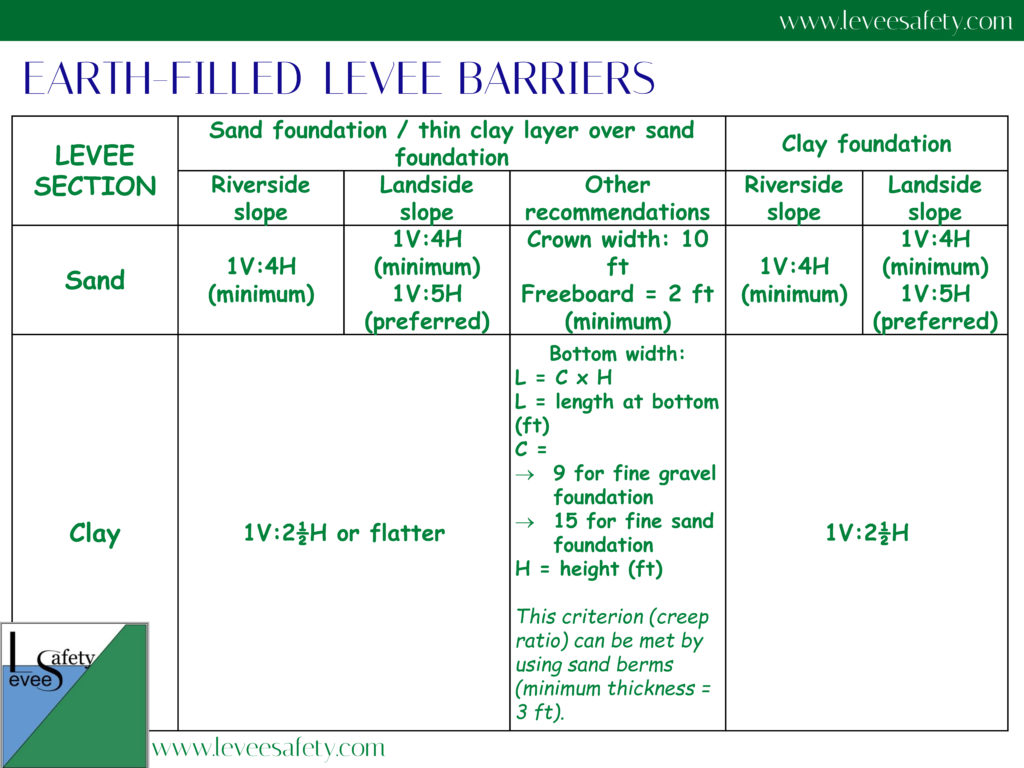
Seepage berms may be required in cases where levees cannot be constructed as recommended above in order to avoid boils or excessive seepage.
Sand berms have been found to be the most effective berm to relieve uplift pressures in an open area.
Conversely, clay berms do not dissipate any uplift pressure and are difficult to construct during unfavorable conditions.
COMPACTION
Compaction is critical to stability and improper compaction can lead to levee failures. The placement of material should be done in lifts (approximately 6” high) to achieve the best compaction.
When the next lift is placed, the top of the previous lift should be mixed with the next to ensure different materials are blended together (blending prevents the two lifts from sliding on one another).
SLOPE PROTECTION
During a flood emergency, time, availability of materials, cost and construction capability may preclude the use of most normally accepted methods of permanent slope protection.
Factors that influence whether or not additional scour protection is required include:
- levee material: clay levees are more resistant to scour than sand levees;
- channel velocities;
- presence of ice or debris;
- wave action;
- seepage.
Plastic sheeting or polyethylene (poly) has been shown to be an effective way to provide erosion slope protection and seepage reduction in a flood situation.
While poly and sandbags are effective and simple forms of slope protection that are typically used as temporary scour protection, issues when using riprap (large, heavy, angular stone layered on slopes) for flood fighting are:
- relatively high cost
- large quantity may be necessary
- limited availability
- little control over placement (particularly in the wet).
2. SANDBAGS
Sandbags have been traditionally used to build temporary barriers to hold back floodwaters.
In fact, sandbag barriers have been the method of choice to raise the height of levees and to protect infrastructure from rising floodwaters.
However, even if sandbags are readily available and familiar to the general public, sandbag structures are labour intensive and time consuming to construct.
The construction of sandbag systems takes time (which is clearly in short supply during a flood event). The filling and closing of sandbags and their transport present logistical problems. Sandbag filling machines and sewing machines for closing the sandbags can simplify and speed up the process but these machines are subject to frequent downtimes.
Moreover, a significant clean-up effort is necessary when the crisis has passed because of the huge amount of solid waste generated. Therefore, there has long been a desire to find alternatives to sandbags that can overcome the above limitations.
SANDBAG LEVEES
Since levees built of only sandbags require a tremendous amount of manpower labour, they should be used where low (5 ft high is the practical limit of a sandbag levee) and short barriers are required and earth fill would not be practicable. Moreover, for stability, the sandbag levee should be kept as short and low as possible. They are useful in constricted areas and where roads temporary closures are required.
Recommended method for sandbag levee construction (USACE, 2018):
- bags should be placed lengthwise and overlapped parallel to the direction of the river flow;
- the base of the sandbag levee should be three times as wide as the levee is high;
- the following layer of bags should be staggered parallel to the previous layer and placed over the seams of the previous layer, with additional layers laid in alternating directions to the top of the sandbag levee;
- each layer should be compacted by walking over the tightly placed bags.
3. TEMPORARY FLOOD PROTECTION PRODUCTS
Since enormous material and personnel costs are required when using sandbag systems to reinforce levees at risk of breakage and to protect low-lying areas against flooding, industry has developed several temporary flood protection products that have proven to be effective and, in many cases, more expedient to install than sandbag levees. There exist numerous manufacturers of these products and several solutions.
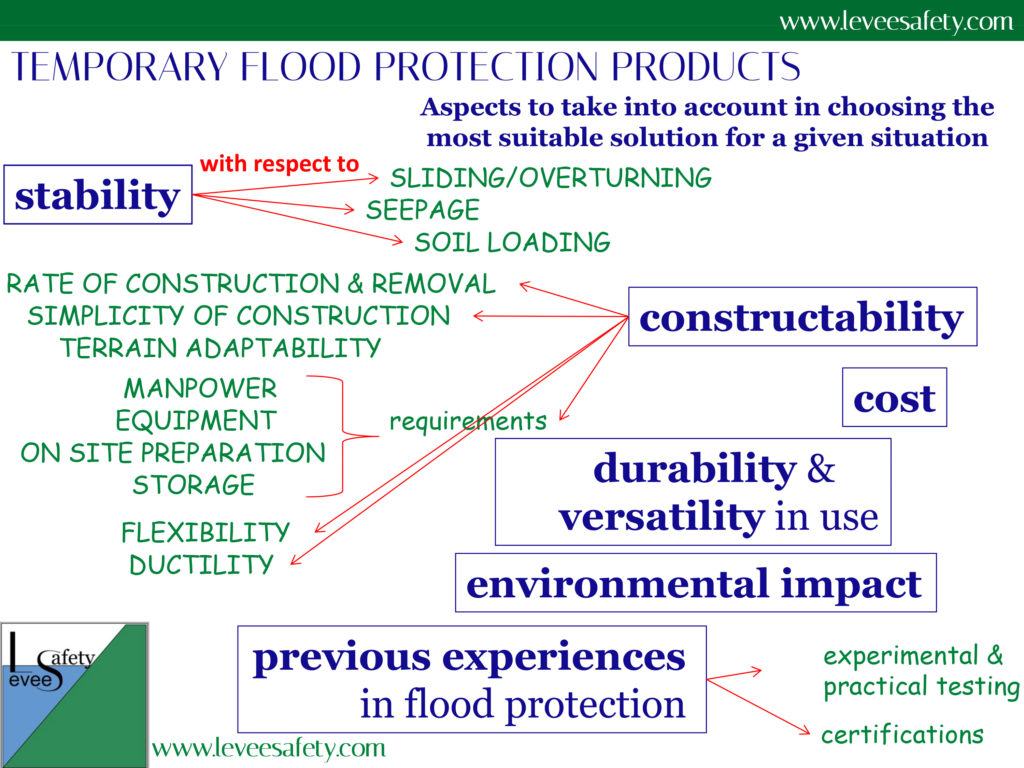
The efficiency of a method is often situation-dependent. In choosing the most suitable solution for a given situation, the following aspects of each alternative should be assessed:
I. STABILITY
a. Factors of safety against sliding and overturning (which are commonly used in assessing stability of a structure in geotechnics).
b. SEEPAGE. Flooding water can seep below and through the water barrier (e.g. section joints). The problem grows with the duration of high levels of retained water.
c. SOIL LOADING. The loading exerted on the structure base is not an issue for gravity structures, having a large continuous footprint area. Conversely, soil loading becomes important when considering the structures consisting of a panel with supporting legs or of similar design. The load, when applied to soft, compressible soil, produces settlement of the leg and corresponding deformation of the whole structure. Excessive deformation may cause destabilization of the structure as a whole. Therefore, the range of applicability of such systems is limited. In fact, they can not be considered feasible for soft grounds.
II. CONSTRUCTABILITY
a. RATE OF CONSTRUCTION & REMOVAL (man-hours for construction and disassembly). Since time is usually lacking in a flooding situation, this is, beyond a doubt, one of the crucial factors for evaluating a temporary flood protection product.
b. SIMPLICITY OF CONSTRUCTION (e.g. suitability for construction by unskilled labour). A protection system should be as simple as possible. Simpler structures for which installation is intuitive are preferable over structures which require specialized knowledge and experience in their assembling considering that manpower in flood protection mainly consists of volunteers.
c. TERRAIN ADAPTABILITY. Adaptability to changing terrain conditions is related to flexibility in use of the protection system. This question arises when one particular protection method must be able to cover large areas consisting of zones with different features. In such cases, it is desirable, from both financial and organizational aspects, to be able to apply the same defence method for the whole area.
d. MANPOWER REQUIREMENTS. Systems with lower labour requirements are preferable. Moreover, since often the manpower available includes individuals without relevant skills, systems which do not assume technical education or special skills are rated better than others. (The expenses for training personnel with manufacturer’s supervision during trial construction of the protection structure are commonly included in the purchase price. Sometimes, they are offered free of charge, as incentives).
e. EQUIPMENT REQUIREMENTS. They should be considered both special equipment requirements and reasonableness of special equipment when considering use at a remote location. In fact, a major problem is the accessibility for heavy equipment in rural areas and remote sites. Problems may also arise with the systems which require filling material.
f. ON SITE PREPARATION REQUIREMENTS. On site preparation should be reduced to a minimum. Segmented structures which can be placed without special requirements regarding the base ground (e.g. cutting roots, levelling etc.) and assembled without any special equipment are preferable. Suitability for construction on sloping or uneven ground is preferable.
g. STORAGE REQUIREMENTS. Storage requirements of structures and materials (including space and other considerations such as exposure to elements: sunlight, temperature, acid rain, etc.) should be carefully considered. Better storage conditions can increase the lifetime of a structure, reducing costs to some extent. The protective systems which involve some type of inflation/deflation procedure are convenient because of smaller storage space needed.
h. FLEXIBILITY
- Ability to fix or strengthen the system in use. Since if water bursts through at a single point the whole defence line breaks down, it is important to have a flexible system which allows its efficient and fast repair or strengthening during a flood event.
- ASSORTMENT & MODULARITY (variety of standard shapes and sizes which can be connected together to form structures of varying geometry and structural characteristics). This issue is related to the adaptability requirements. In fact, it enables an optimization of the defence to given circumstances (e.g. ability to increase structure height to hold back one additional foot of water after its initial construction).
i. DUCTILITY of the structure. If a structure does not collapse suddenly but gives some signs of overloading (e.g. excessive deformation or movement), appropriate measures to repair it or support it in due time can be undertaken.
III. COST
The expenses should be estimated in total. Removal expenses should not be forgotten in calculating the total cost. The initial investment (purchase cost) is just a part of the total cost of a protection system. Sometimes a higher purchase cost may be connected with less expensive maintenance. Installation costs depend on the requirements of specialized equipment and tools. Simpler methods, which involve only extensive manual work, are usually considered much cheaper.
IV. DURABILITY AND VERSATILITY IN USE
Durability depends on whether a system is designed for a single use or as a multiple-use structure and what is the degree of survival of its parts. In fact, even if certain systems are intended for multiple use, they may be deformed so much that they can not be used again. Reusability may be more an economic than a technical issue: the cost for repair may closely approach the cost of purchase of a new structure.
Versatility is a desirable feature. A versatile system, when not in primary function, may be used for other purpose and then it may partly repay itself. However, when considering versatility, it should be considered that primary uses of the system often limit future ones (e.g. if the geomembrane tubes were used in flood protection, filled with flooding water, they can not be used for storing drinking water any more, unless completely cleaned and disinfected).
V. ENVIRONMENTAL IMPACT
Environmental considerations are needed.
Systems constructed of environmentally acceptable materials are preferable.
Any negative impact on the environment should be carefully evaluated in advance (e.g. need to dispose of large volumes of contaminated material after flood event).
VI. PREVIOUS EXPERIENCES in flood protection (experimental and practical testing/certifications)
Temporary flood protection systems are technical systems whose functional capability must be proven before their use in an emergency.
Currently, many countries (e.g. Italy, Germany, etc.) do not have certifications and testing systems in place for checking the functionality of temporary flood protection systems so that systems can be brought onto the market even without independent certification.
However, the available literature (e.g. Biggar & Masala, 1998) provides the flood-fighting community with results that could assist in the selection of the product that best fits their requirements.
In 2004, the U. S. Army Engineer Research and Development Center (ERDC) conducted research and developed a comprehensive laboratory and field testing program for the scientific evaluation of the temporary flood-fighting structures (ERDC TR-07-3 July 2007; Wibowo & Ward, 2016). Laboratory and field testing was conducted in Vicksburg, MS, under stringent testing protocols. Sandbags and three different commercial products were tested (two basin systems with sand filling and a trestle system):
- Rapid Deployment Flood Wall (RDFW) consists of granular filled, plastic grid units that connect together with both horizontal and vertical tabs to form a continuous structure
- Portadam consists of an impermeable membrane liner that is supported by a steel frame.
- Hesco Bastion Concertainers are granular-filled, membrane-lined wire baskets that are pinned together to form a continuous structure.
In both the laboratory and field testing, a standard sandbag levee was constructed to provide a baseline by which the other products could be compared.
To compare different barriers, the ERDC developed a standard testing protocol to evaluate flood-fighting structures. The evaluation included time, ease and cost of construction, performance under hydrostatic and wave loading, overtopping, debris impact, possible repair, reuse, environmental impact and cost. Laboratory and field testing results showed that the sandbag structure (constructed following the protocol used by the USACE Seattle District) was time consuming to construct, requiring much longer time than the other three structures. The sandbag levee was very resistant against debris impact loading but only the sandbag levee breached during the overtopping. Commercial products were able to withstand the stresses and strains and showed only minor damage after the impact tests.
The results of the test series served as a basis for the development of the U.S. national standard for flood barrier product resulting in FM Approval Standard 2510 adopted by the American National Standards Institute. ANSI/FM 2510 is a standard that evaluates the performance of the product in realistic flood conditions and the components and materials that comprise the product.
In Great Britain, the British Standard Institution (BSI) developed a standard (PAS 1188-2:2014 recently replaced by BS 851188-2:2019) that specifies how temporary flood protection systems must be tested for functionality.
The Institute for Hydraulic and Coastal Engineering of the Bremen University of Applied Sciences, Germany (IWA) has set up a test facility and has carried out systematic test setups of temporary flood protection systems (Massolle et al., 2018).
Even if new methods and modifications of known systems continually appear, temporary flood protection products typically fall into some main categories:
A. Cellular barriers
B. Flood barriers
C. Air/water filled tubes
A. Cellular (gabion-like) barriers
(often referred to as lined gabion baskets or basin systems)
They are prefabricated flexible cellular structures (wire-mesh cages) filled with rock or soil on site. Essentially, these are collapsible multi-cellular structures, made of panels of wire mesh reinforced with vertical steel bars. Flexibility of the metal cage and hinged structural connections enable good adaptation to local terrain conditions. Impermeability of the structures is achieved by geotextile liners and by the filler.
Advantages
- The variety of sizes and lengths in which these products are offered enables versatility in use.
- This type of structure does not pose any constraints to the base soil, the relief, the filling material, etc. and can be relatively simply constructed on both level and sloping surfaces.
- It is easy to raise the height by adding another row of cells atop an existing wall.
- Since the simplicity of design unskilled labour can be employed for installation.
- Main advantages of cellular barriers over traditional sandbag leveees are in much less time and manpower required for filling and installation.
- They are easy to handle and transport (collapsed, in pallets).
- There are no special requirements for storage and the space needed for storing is very small (collapsible structures). When collapsed, they occupy less volume and they do not need closed storage space or sheltering. Usually, the cages are kept in pallets in the open air, since the wire mesh is galvanized and the geosynthetics is durable to weather action.
- It is possible to reuse metal cages (if not significantly deformed).
- Robustness, low cost and speed of installation (when machine filling is possible). They are assembled and installed quickly but fill requires heavy equipment.
- The cellular wall is resistant to floating debris impacts, wave action and low temperatures.
Disadvantages
- The need for heavy equipment to speed the construction raises the question of site accessibility: cellular structures are not suitable for places where soft saturated clays are the foundation soil, unless they are filled manually.
- Large hydraulic gradients beneath the structure may become a problem under prolonged exposure to flooding water due to the possibility of soil erosion (particularly in looser silty and sandy soils).
- Need to dispose of large volumes of probably contaminated material after flood events.
Examples:
PERMEABLE filled containers are cellular barriers filled with aggregates. The barrier materials are typically geotextile or geosynthetic fabrics. As the geotextile liners are not impermeable, water tightness is achieved by the mass of material with which they are filled.
This type of barrier functions as gravity dams (depending on their weight for stability). They are generally flexible and adapt well to uneven terrain.
IMPERMEABLE filled containers are barriers made of impermeable materials (e.g. polyester, polyethylene, plastic). The containers themselves are impermeable and are filled with water or aggregates only to provide additional weight (they can be filled with any available material).
These systems are generally more rigid than permeable filled containers and do not adapt as well to uneven terrain (some ground preparation is necessary before installation). Significant seepage may occur under the barriers due to their rigidity.
Examples:
B. Flood barriers
Free-standing flood barriers are made of free-standing heavy duty sections, which are self-supporting. The barrier material is flexible and impermeable. The stability of these barriers depends on the weight of water acting on a long skirt on the upstream side of the defence resisting the imposed loading on the barrier. The length of the skirt is designed to ensure adequate stability.
Seepage may occur at low water levels.
Sometimes, the materials used for the barriers are susceptible to tear or puncture but can be repaired during service conditions. They are easily cleaned and reusable. Deployment does not require any equipment, and is quick and easy.
Advantages:
- Quick and easy to install (no equipment required)
- Small storage space required
- Easily transportable
- Low bearing pressure on bedding surface
- Easily reusable
Disadvantages:
- Susceptible to leakage at low water levels
Examples:
Frame barriers (often referred to as trestle systems, portable diversion dams or cofferdam structures) consist of metal frames with non-rigid impermeable membranes spanning between them. They adapt well to various terrain conditions but exert high bearing pressures on the bedding surface hence may not be suitable for areas with direct application onto soft soils. They are assembled and installed quickly, do not require fill material and can be used on many angles but are unable to raise height after installed.
Advantages:
- quick and easy to install (no equipment required)
- do not require fill material
- can be used on many angles
Disadvantages:
- high bearing pressure on bedding surface
Examples:
Panel barriers are pre-fabricated concrete, steel or other rigid panel elements connected together to form a continuous barrier.
They are gravity structures, durable and reusable, very resistant to impact and vandalism.
Conversely, they transmit high bearing pressures on the bedding surface and may not be suitable for direct erection on soft soils. Seepage under the barriers is often significant due to their rigidity.
Jersey highway barriers, for example, are concrete removable structures which can be combined with polyethylene sheeting in order to form a hydraulic barrier. In flood control, they may be used for levee raising and for lower retained heads of floodwater (up to 0.5 m).
The system does not need storing but requires the use of heavy equipment. This may limit its feasibility to strong soil and rock surfaces, as well as to urban areas because of the access required by heavy transportation vehicles. Because of site accessibility requirements, applicability of this method is limited to urban conditions with good accessibility or to the areas where the units are already available and the road network is developed. Its use is best suited for flat terrain and for long straight defence lines because of difficulties in achieving corners.
Advantages:
- simplicity
- fast installation, if heavy construction equipment and the units are available on site
- durability in use (no damages and no maintenance expenses)
Disadvantages:
- site accessibility for heavy equipment limits its use in rural areas and places with soft soils in the foundation.
C. AIR OR WATER FILLED TUBES
These flood protection products are typically pre-fabricated geomembrane tubes filled with air or water to form a dam. The tubes are normally portable and require pumps for inflation (they require little storage space when deflated).
The water-filled tubes are gravity dams, which use the weight of water to provide stability.
To prevent rolling, most systems have some form of anchoring.
Inflatable (water or air-filled) tubular geomembranes have the widest possible area of application: they can be used both in urban and rural areas (regarding the ground requirements and available space at the surface), almost without restrictions regarding the relief and underlying soil. They have the fastest installation time and least requirements regarding the equipment. They are very good as closure structures for still and slowly flowing water (up to 1.5 m high).
They are susceptible to tears and punctures, which can usually be repaired during service.
Advantages:
- fast installation
- lowest requirements for labour and professional skills
- particularly easily adaptable to uneven ground
- low bearing pressure on the bedding surface
- versatility: can be used for many other emergency or operational scenarios
- small storage space required
- easily transported
- easily cleaned and reusable.
Disadvantages:
- high initial cost
- questionable durability against floating debris carried by water current.
Examples:
Water-filled tube systems:
Air-filled tube systems:
In many situations a combination of techniques can give the best possible results.
However, planning and preparation is always needed in order to achieve full efficiency.
Proper planning improves response time and success.
Finally, a stockpile of necessary supplies and equipment used to respond to typical high-water events should be maintained.
REFERENCES
ANSI/FM Approvals Standard 2510. Approval standard for flood abatement equipment. ANSI, American National Standard Institute & FM, Norwood, MA, USA, February 2014.
Biggar, K.; & Masala, S. (1998). Alternatives to sandbags for temporary flood protection. Alberta Transportation and Utilities Disaster Services Branch and Emergency Preparedness, Canada, October 1998.
BS 851188-2:2019. Flood resistance products. Perimeter barrier systems. Specification. The British Standards Institution, 2019
DEFRA (2002). Temporary and Demountable Flood Protection. Interim Guidance on Use. R&D Publication 130. Environment Agency, August 2002, ISBN 1 857 05845 3
ERDC TR-07-3 July 2007. Flood-Fighting Structures Demonstration and Evaluation Program: Laboratory and Field Testing in Vicksburg, Mississippi. July 2007. Final report. US Army Corps of Engineers, Washington, DC.
Massolle, C.; Lankenau, L. & Koppe, B. (2018). Emergency Flood Control: Practice-Oriented Test Series for the Use of Sandbag Replacement Systems. Geosciences, 2018, 8, 482; doi:10.3390/geosciences8120482
PAS 1188-2:2014. Flood protection products. Specification. Temporary products. The British Standards Institution, 2014, ISBN 978 0 580 85754 6.
USACE (2018). Handbook For Emergency Flood Risk Management, 2018. U. S. Army Corps of Engineers – Rock Island District.
Wibowo, J.L. & Ward, D.L. (2016). Evaluation of temporary flood-fighting structures. FLOODrisk 2016 – 3rd European Conference on Flood Risk Management. DOI: 10.1051/e3sconf/20160703017
DISCLAIMER
The information contained in this post is intended as a technology overview only (based on the information available to the author) and is in no way intended as an official endorsement of one particular product or technology by the author or sponsoring agencies.
